

Climate Reality. Fifth Assessment Report. The decision to prepare a Fifth Assessment Report (AR5) was taken by the members of the IPCC at its 28th Session (09-10 April 2008, Budapest, Hungary).
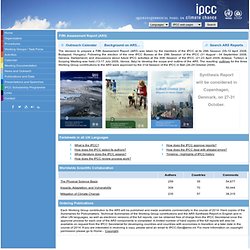
Following the election of the new IPCC Bureau at the 29th Session of the IPCC (31 August - 04 September 2008, Geneva, Switzerland) and discussions about future IPCC activities at the 30th Session of the IPCC (21-23 April 2009, Antalya, Turkey), a Scoping Meeting was held (13-17 July 2009, Venice, Italy) to develop the scope and outline of the AR5. Fifth Assessment Report - Impacts, Adaptation and Vulnerability.
Click to on the link to download the chapter, graphics, authors etc.
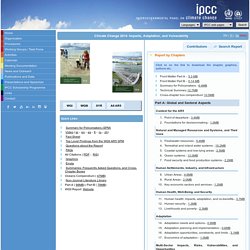
Front Matter Part A - 5.3 MBFront Matter Part B - 0.14 MBSummary for Policymakers - 6.4MB Technical Summary 12.7MB Cross-chapter box compendium 10.5MB Part A: Global and Sectoral Aspects. Climate change is putting world at risk of irreversible changes, scientists warn. The world is at growing risk of “abrupt, unpredictable and potentially irreversible changes” because of a warming climate, America’s premier scientific society warned on Tuesday.
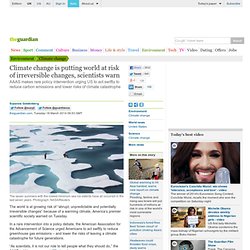
In a rare intervention into a policy debate, the American Association for the Advancement of Science urged Americans to act swiftly to reduce greenhouse gas emissions – and lower the risks of leaving a climate catastrophe for future generations. “As scientists, it is not our role to tell people what they should do,” the AAAS said in a new report, What we know. “But we consider it our responsibility as professionals to ensure, to the best of our ability, that people understand what we know: human-caused climate change is happening, we face risks of abrupt, unpredictable and potentially irreversible changes, and responding now will lower the risks and costs of taking action.” NASA-Backed Study Says Humanity Is Pretty Much Screwed (Updated) Enrique Peñalosa: Why buses represent democracy in action. Is There Anything More Beautiful Than This? Environmental awareness - UNESCO Multimedia Archives. Language(s): English.

Climate Change: Pictures, Videos, Breaking News. Ken Wilber talking on Ayahuasca. Gamechanger: Next Generation Wind Turbines With Storage Are Cheap, Reliable And Brilliant. By Ryan Koronowski "Gamechanger: Next Generation Wind Turbines With Storage Are Cheap, Reliable And Brilliant" What makes a new wind turbine exciting?
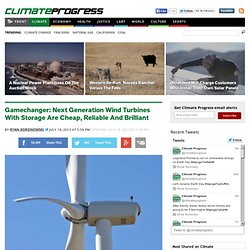
Wind companies are always trying to making their next turbine spin more efficiently and generate more power than the last, just as car companies are looking for better fuel efficiency and engine power. Advances usually come in small jumps in both cases, with a single percentage improvement cause for celebration. GE announced a new line of wind turbines in May that generate between 20 and 24 percent more power than the previous best turbine in its class. The wind does not blow all the time, and the electric grid needs a regular supply of electricity. Can advances in technology allow renewable energy sources to be reliable for second-to-second grid use? This is a big deal, for grid operators and wind energy producers. Heavy Rains Send Iowa's Precious Soil Downriver : The Salt. What a difference a year makes.

Last year at this time, the Midwest was heading into one of the worst droughts in decades. Now much of the region is soggy. But the biggest loser from this year's heavy rains? The land itself. The Environmental Working Group, drawing on analysis done by Iowa State University's Iowa Daily Erosion Project, found in a recent report that during one five-day period in May, 50 townships in Iowa lost more than 5 tons of topsoil per acre. Evolution Can't Keep Pace with Climate Change. Image via Shutterstock Exxon Mobil CEO Rex Tillerson made headlines last year when he famously dismissed climate change as something that we should just adapt to, but new research shows that most species won’t be able to adapt soon enough to a rapidly changing climate.
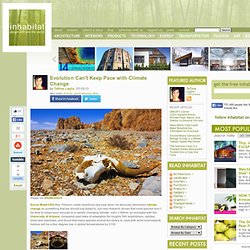
John J Wiens, an ecologist with the University of Arizona, compared past rates of adaptation for roughly 540 amphibians, reptiles, birds and mammals, and found that many species evolve too slowly to cope with what most experts believe will be a four degree rise in global temperatures by 2100. Image via Shutterstock. What Climate Change Means for Africa, Asia and the Coastal Poor. Sub-Saharan Africa In Sub-Saharan Africa, the researchers found food security will be the overarching challenge, with dangers from droughts, flooding, and shifts in rainfall.
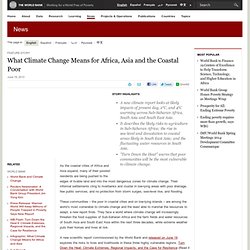
Between 1.5°C-2°C warming, drought and aridity, will contribute to farmers losing 40-80 percent of cropland conducive to growing maize, millet, and sorghum by the 2030s-2040s, the researchers found. In a 4°C warmer world, around the 2080s, annual precipitation may decrease by up to 30 percent in southern Africa, while East Africa will see more rainfall, according to multiple studies.
Ecosystem changes to pastoral lands, such as a shift from grass to woodland savannas as levels of carbon dioxide increase, could reduce food for grazing cattle. South East Asia In South East Asia, coastal cities will be under intense stress due to climate change. South Asia. New Satellite Map from NASA and NOAA Shows All the World's Vegetation. Just how much greenery covers the Earth?
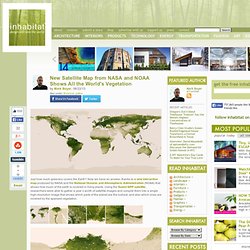
Now we have an answer, thanks to a new interactive map produced by NASA and the National Oceanic and Atmospheric Administration (NOAA) that shows how much of the earth is covered in living plants. Using the Suomi NPP satellite, researchers were able to gather a year’s worth of satellite images and compile them into a single high-resolution image that shows which parts of the planet are the lushest, and also which ones are covered by the sparsest vegetation. The “Vegetation on Our Planet” image isn’t a mere snapshot of the Earth – that would be misleading because some areas would be experiencing winter while others enjoy the summer sun. U.N. online platform to help scientists and climate change experts.
New online tool will be helpful in REDD+ efforts.

Photo taken from the Food and Agriculture Organization of the United Nations The Food and Agriculture Organization of the United Nations has initialized the very first online platform to help scientists and climate change experts to access tree models for forest volume, biomass, and carbon strocks assessment. The online platform, called GlobAllomeTree, makes use of allometric equations which can be used to assess different forest services such as timber production, as well as bioenergy strategies which include forest volume, biomass, and forest carbon. Climate Literacy: Navigating Climate Change Conversations. An Ethical Analysis of Obama’s Climate Speech, the Adverse Political Reaction to It, and the Media Response. On June 25th, President Obama gave a major speech on climate change in which he announced what his administration would do to reduce greenhouse gas (ghg) emissions in the United States. Although the US Congress has continued to fail to act on climate change since climate negotiations began in 1990, President Obama identified administrative actions that he would take that did not depend upon US congressional action.
As we shall see, the speech was significant for some of the ethical issues touched upon in the speech. The Scariest, Most Shocking Climate Change Video of 2012: Skywatcher. How to Build a Cooler City. CHICAGO | On a sweltering day in July 1995, Luxora Coleman returned to her Chicago home to find her husband, Oliver, unmoving on his living room couch. With a weak heart and only a ceiling fan to battle temperatures that had soared to 106 degrees, the heat wave had proved too much for him. He was pronounced dead later that day. Coleman’s husband was one of thousands of residents left without air conditioning over the four days that summer when the heat index reached 120 degrees.
Roads buckled, cars broke down and many areas lost power. Global Warming Causes and Climate Change Facts. Science says: Negative impacts of global warming on agriculture, health, and environment far outweigh any positives. While CO2 is essential for plant growth, all agriculture depends also on steady water supplies, and climate change is likely to disrupt those supplies through floods and droughts. It has been suggested that higher latitudes—Siberia, for example—may become productive due to global warming, but the soil in Arctic and bordering territories is very poor, and the amount of sunlight reaching the ground in summer will not change because it is governed by the tilt of the earth.
Noam Chomsky: How Climate Change Became a 'Liberal Hoax' Climate will alter the soil that feeds us. How to talk to a climate change denier. Green-Fire-Reconsidered.